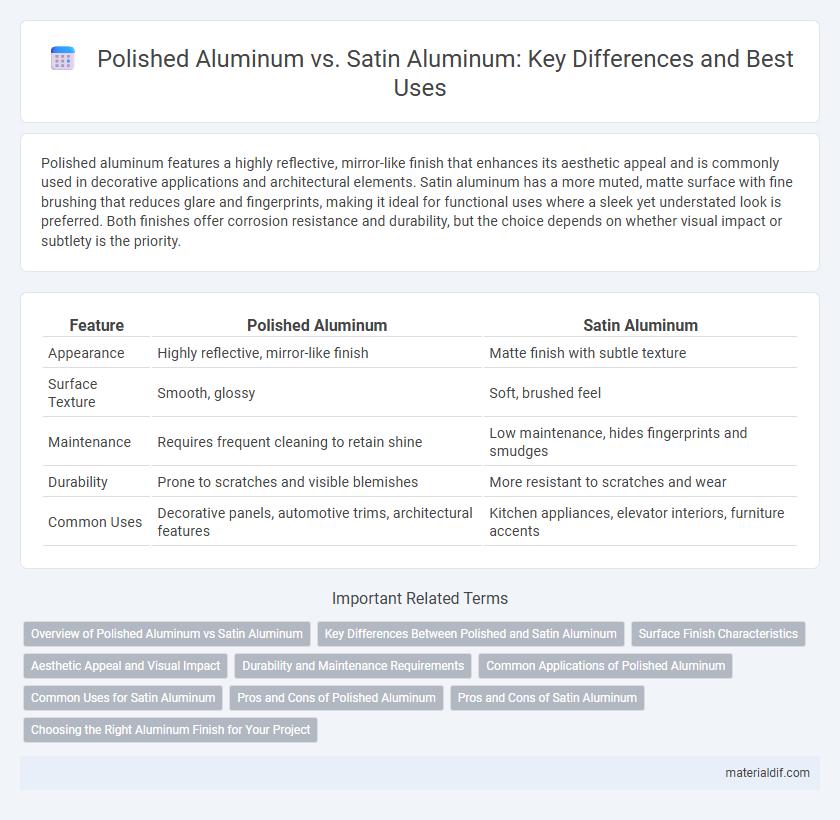Polished aluminum features a highly reflective, mirror-like finish that enhances its aesthetic appeal and is commonly used in decorative applications and architectural elements. Satin aluminum has a more muted, matte surface with fine brushing that reduces glare and fingerprints, making it ideal for functional uses where a sleek yet understated look is preferred. Both finishes offer corrosion resistance and durability, but the choice depends on whether visual impact or subtlety is the priority.
Table of Comparison
| Feature | Polished Aluminum | Satin Aluminum |
|---|---|---|
| Appearance | Highly reflective, mirror-like finish | Matte finish with subtle texture |
| Surface Texture | Smooth, glossy | Soft, brushed feel |
| Maintenance | Requires frequent cleaning to retain shine | Low maintenance, hides fingerprints and smudges |
| Durability | Prone to scratches and visible blemishes | More resistant to scratches and wear |
| Common Uses | Decorative panels, automotive trims, architectural features | Kitchen appliances, elevator interiors, furniture accents |
Overview of Polished Aluminum vs Satin Aluminum
Polished aluminum features a highly reflective, mirror-like surface achieved through extensive buffing and polishing processes, offering superior brightness and a smooth finish ideal for decorative applications. Satin aluminum, on the other hand, undergoes a brushing or bead blasting process that creates a matte, low-gloss surface with fine texture, enhancing scratch resistance and reducing glare. The choice between polished and satin aluminum depends on desired aesthetics, maintenance requirements, and functional performance in specific environments.
Key Differences Between Polished and Satin Aluminum
Polished aluminum features a highly reflective, mirror-like finish achieved through buffing and polishing processes, enhancing its aesthetic appeal and resistance to corrosion. Satin aluminum, on the other hand, has a matte, non-reflective surface created by abrasive brushing or bead blasting, which hides fingerprints and minor scratches more effectively. The key difference lies in their surface texture and shine, with polished aluminum offering a glossy appearance while satin aluminum provides a subdued, elegant look with better durability against wear.
Surface Finish Characteristics
Polished aluminum features a highly reflective, mirror-like surface that enhances brightness and creates a smooth texture with minimal imperfections. Satin aluminum offers a matte finish with a soft sheen, achieved through fine abrasive brushing that conceals fingerprints and minor scratches. The choice between polished and satin aluminum affects durability, maintenance, and aesthetic appeal in architectural, automotive, and decorative applications.
Aesthetic Appeal and Visual Impact
Polished aluminum exhibits a highly reflective, mirror-like finish that enhances brightness and delivers a sleek, modern aesthetic ideal for contemporary designs. Satin aluminum offers a smooth, matte surface with a soft sheen that reduces glare and provides a subtle, sophisticated visual impact suited for understated elegance. Both finishes highlight aluminum's lightweight durability, but polished aluminum accentuates vivid reflections while satin aluminum emphasizes texture and depth.
Durability and Maintenance Requirements
Polished aluminum offers a reflective, mirror-like finish that is susceptible to scratches and fingerprints, requiring frequent cleaning and polishing to maintain its appearance. Satin aluminum features a matte, brushed texture that better conceals fingerprints and minor imperfections, reducing the need for intensive maintenance. Both finishes provide strong corrosion resistance, but satin aluminum generally offers greater durability in high-traffic or outdoor environments due to its lower visibility of wear.
Common Applications of Polished Aluminum
Polished aluminum, known for its reflective, mirror-like finish, is commonly used in automotive trim, decorative hardware, and architectural accents where aesthetic appeal is essential. Its smooth surface enhances corrosion resistance, making it suitable for marine applications such as boat fittings and yacht railings. High visibility and durability also make polished aluminum a preferred choice in signage and lighting fixtures.
Common Uses for Satin Aluminum
Satin aluminum is commonly used in architectural and interior design applications because of its smooth, matte finish that reduces glare and fingerprints while maintaining a sleek appearance. It is frequently found in kitchen appliances, furniture, and automotive trim, where durability and aesthetic appeal are essential. The satin finish also enhances resistance to scratches and wear, making it ideal for high-traffic surfaces and functional hardware.
Pros and Cons of Polished Aluminum
Polished aluminum offers a highly reflective, mirror-like finish that enhances aesthetic appeal and provides excellent corrosion resistance when properly maintained, making it ideal for decorative and automotive applications. However, polished aluminum requires frequent cleaning and buffing to prevent oxidation and maintain its shine, which can be labor-intensive and costly over time. Despite its vulnerability to scratches and fingerprints, its superior brilliance remains unmatched compared to the more muted, matte texture of satin aluminum.
Pros and Cons of Satin Aluminum
Satin aluminum offers a smooth, matte finish that reduces glare and fingerprints, making it ideal for applications requiring a subtle, elegant appearance. Its surface durability resists scratches better than polished aluminum, though it may be harder to clean due to its textured finish. Satin aluminum's corrosion resistance and low maintenance needs make it suitable for architectural panels and automotive trim, but it lacks the high reflectivity and mirror-like shine found in polished aluminum.
Choosing the Right Aluminum Finish for Your Project
Polished aluminum offers a high-gloss, mirror-like surface that enhances aesthetic appeal and is ideal for decorative applications requiring a reflective finish. Satin aluminum features a smooth, matte texture that reduces glare and fingerprints, making it suitable for functional projects where durability and subtle elegance are priorities. Selecting the right aluminum finish depends on balancing visual impact with maintenance needs and environmental exposure to achieve the desired performance and appearance.
Polished Aluminum vs Satin Aluminum Infographic

 materialdif.com
materialdif.com